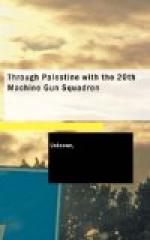[33] It is a strange coincidence
that a stream close to Jedeide is
called “El Maut,”
which means “Death".
THE VALLEY OF LEBANON-RAYAK.
Henceforward, the 5th Cavalry Division was to become an entirely separate force in its operations—indeed, at one time, its nearest support was 100 miles distant. Two days were spent at El Judeide, grazing horses and cleaning guns and saddlery, before making another move forward. A force of Turks some 7,000 strong was reported to be at Rayak Junction on the Beirut Railway 30 miles north-east of Damascus, and on October 5th at 06.00 the Division, with the 14th Brigade leading (the “S.R.Y.” had re-joined from Haifa), set off to deal with them. “No. 2” Section was with the advance guard.
Across country to Sabura, they reached the main Beirut Road at Khan Dimez, 15 miles from Damascus, and halted for the night at Khan Meizebun a few miles further on, with outposts out. Following the road to the bridge over the river, south of Bar Elias (where a halt for water was made), the advance guard ("No. 1” Section with it), was much surprised at the extraordinary behaviour of the natives, who, sighting them from a distance, galloped to meet them, firing their rifles in the air and shouting. Such was their method of giving us welcome; it would have been their own fault if they had been mistaken for the enemy, as they very nearly were!
At this point, turning north along a track up the Valley of Lebanon[34] (many miles wide) the Brigade pushed on to Rayak. All along the road, right from Khan Dimez, the previous day, there was evidence of the sorry plight of the Turk. Hundreds of dead horses, dead bodies (stripped by the villagers), broken wagons and even overturned “gharries” strewed the route.
FOOTNOTES:
[34] "Lebanon” means “White,” probably employed because of the snow which can be seen most of the year on the Lebanon range of mountains, on the western side of the valley (see Jer. xviii, 14). Lebanon is stated in the Bible to be on the northern border of the Promised Land (Deut. i, 7, iii, 25, xi, 24; Josh. i, 4, ix, 1). King Solomon’s palace and temple were built of cedars and firs from Lebanon (I Kings ix, 19), also the second temple (Ezra iii, 7). Other references to Lebanon are Josh. xi, 17, xiii, 2; Judges iii, 1; Deut. iii, 25; II Chron. ii, 2; Psalms xxix, 5, xcii, 12; Isa. xiv, 8, xxxv, 17, xl, 16; Solomon’s Song iv, 8, 11, 15.
AN UNWELCOME WELCOME.
Upon our approaching Rayak, as if at a word of command, suddenly, a tremendous burst of rifle fire broke out! This outburst, however, proved to be merely a demonstration of the population’s welcome! Rayak, and some of the villages in this district, are Christian,[35] and it may well be imagined that the population was simply delirious with joy at the arrival of the British.




